Will Wind–Sand Activity Bury the Opencut Tunnel along the Linhe–Ceke Railway, China?
Abstract
:1. Introduction
2. Material and Methods
2.1. Background of Research Area
2.2. Experiment Design and Set-Up
2.2.1. Wind Tunnel Introduction and Model Design
2.2.2. Data Collection and Analysis
- (1)
- Measurement of the airflow velocity field in the opencut tunnel
- (2)
- Determination of sand flow at the front and rear of the opencut tunnel
- (3)
- Measurement of sand accumulation morphology at the front and rear of the opencut tunnel
- (4)
- Field investigation of sand morphology and particle size
3. Results
3.1. Characteristics of Wind and Sand without the Model
3.2. Characteristics of Airflow Velocity Field with the Opencut Tunnel
3.3. Vertical Distribution Characteristics of Wind–Sand Flow before and after the Opencut Tunnel
3.4. Influence of Wind Direction on the Reattachment Distance of Airflow in the Opencut Tunnel
4. Discussion
4.1. The Relationship between Wind Direction Angle and Airflow Velocity Field and Sand Transport
4.2. Field Demonstration of the Wind–Sand Environment in the Opencut Tunnel
4.3. Analysis on the Possibility of Sand Burial in the Opencut Tunnel
4.4. Limitations of This Research
5. Conclusions
- (1)
- The sediment transport on the windward and leeward sides increased with increasing wind speed. More than 85% of the sediment transport on the windward side occurred within a height of 0–10 cm, while 80% of the sediment transport on the leeward side occurred within the height of 30–70 cm. The influence of the wind direction angle on the change in windward sediment transport can be roughly divided into four cases: the change process of 90°–60° is the same, the change of 55°–30° tends to be the same, and the maximum sediment transport can be observed at 15°. When considering the same indicated wind speed, with the decreasing wind direction angle, the change in the sand surface area and sediment amount around the opencut tunnel exhibits a continuous increase.
- (2)
- At the micro and macro scale, the grain size characteristics, morphology, movement direction and movement speed of the sand inside and outside the opencut tunnel area are influenced by the construction of the opencut tunnel. The sand particles on the dune surface in the opencut tunnel area are coarse-grained, uniformly sized and centralized. Outside the influence area of the opencut tunnel, the dune movement exhibits a small deflection, the annual linear movement distance is more than 30 m, and the morphology of the dune gradually evolves into a typical barchan dune.
- (3)
- The greater the angle between the opencut tunnel and wind direction, the higher the wind and sand resistance potential. When constructing the sand-control opencut tunnel in similar desert areas, the opencut tunnel should intersect the dominant wind direction at as large an angle as possible. The variation law of airflow velocity profiles under different wind levels and angles shows that the airflow above 0.7 times the height is in a state of acceleration and uplift and no sand-filling phenomenon occurs at the ventilation vent at the top of the open tunnel. In the past 20 years, no accumulation of shifting sand occurred along the opencut tunnel. Affected by the main adverse wind and the acceleration of gathering wind in the opencut tunnel, there was always a certain distance from the sand body along the line to the opencut tunnel and the shifting sand could not bury the opencut tunnel in a small-scale time range. Therefore, an opencut tunnel can be used for railway prevention.
Author Contributions
Funding
Institutional Review Board Statement
Informed Consent Statement
Data Availability Statement
Acknowledgments
Conflicts of Interest
References
- Yan, M.; Wang, H.B.; Zuo, H.J.; Li, G.T. Wind tunnel simulation of an opencut tunnel airflow field along the Linhe-Ceke Railway, China. Aeolian Res. 2019, 39, 66–76. [Google Scholar] [CrossRef]
- Xu, X.; Zhang, K.; Kong, Y.; Chen, J.; Yu, B. Effectiveness of erosion control measures along the Qinghai–Tibet highway, Tibetan plateau, China. Transp. Res. Part. D Transp. Environ. 2006, 11, 302–309. [Google Scholar] [CrossRef]
- Cheng, J.; Jiang, F.; Xue, C.; Xin, G.; Li, K.; Yang, Y. Characteristics of the disastrous wind-sand environment along railways in the Gobi area of Xinjiang, China. Atmos. Environ. 2015, 102, 344–354. [Google Scholar] [CrossRef]
- Xiao, J.H.; Yao, Z.Y.; Qu, J.J. Influence of Golmud-Lhasa section of Qinghai-Tibet Railway on blown sand transport. Chin. Geogr. Sci. 2015, 25, 39–50. [Google Scholar] [CrossRef]
- Zhang, K.C.; Qu, J.J.; Yu, Y.P.; Han, Q.J.; Wang, T.; An, Z.S.; Hu, F. Progress of Research on Wind-blown Sand Prevention and Control of Railways in China. Adv. Earth Sci. 2019, 34, 573–583. [Google Scholar] [CrossRef]
- Mohebbi, M.; Rezvani, M.A. Analysis of the effects of lateral wind on a high speed train on a double routed railway track with porous shelters. J. Wind. Eng. Ind. Aerodyn. 2019, 184, 116–127. [Google Scholar] [CrossRef]
- Song, Y.; Zhang, M.; Iseth, O.; Ronnquist, A. Wind deflection analysis of railway catenary under crosswind based on nonlinear finite element model and wind tunnel test. Mech. Mach. Theory 2022, 168, 104608. [Google Scholar] [CrossRef]
- Zhang, K.; Qu, J.; Han, Q.; Xie, S.; Kai, K.; Niu, Q.; An, Z. Wind tunnel simulation of windblown sand along China’s Qinghai–Tibet railway. Land Degrad. Dev. 2012, 25, 244–250. [Google Scholar] [CrossRef]
- Woldman, M.; Van, H.E.; Schipper, D.J.; Tinga, T.; Masen, M.A. Investigating the influence of sand particle properties on abrasive wear behaviour. Wear 2012, 294, 419–426. [Google Scholar] [CrossRef]
- Kóllmann, J. Railway operations under harsh environmental conditions sand, dust & humidity problems and technical solutions/mitigation measures. In Proceedings of the AHK Workshop Be a Partner of Qatar Rail, Berlin, Germany, 17 April 2013. [Google Scholar]
- Tyfour, W.R. Predicting the effect of grinding corrugated rail surface on the wear behavior of pearlitic rail steel. Tribol. Lett. 2008, 29, 229–234. [Google Scholar] [CrossRef]
- Thake, T. ERTMS Implementation in Saudi Arabia; International Strategic Rail Forum: Abu Dhabi, United Arab Emirates, 2012. [Google Scholar]
- Selig, E.T.; Waters, J.M. Track Geotechnology and Substructure Management; Thomas Telford Services Ltd.: London, UK, 1994. [Google Scholar]
- Esmaeili, M.; Aela, P.; Hosseini, A. Experimental assessment of cyclic behavior of sand-fouled ballast mixed with tire derived aggregates. Soil Dyn. Earthq. Eng. 2017, 98, 1–11. [Google Scholar] [CrossRef]
- Wang, X.; Zhang, D.; Jiang, Y.; Jiang, F.; Li, Y. Drifting sand disasters and engineering control along south Xinjiang railway line. Chin. J. Geol Hazard. Control. 2007, 18, 59–63. [Google Scholar] [CrossRef]
- Zhang, K.C.; Qu, J.J.; Liao, K.T.; Niu, Q.H.; Han, Q.J. Damage by wind-blown sand and its control along Qinghai-Tibet Railway in China. Aeolian Res. 2010, 1, 143–146. [Google Scholar] [CrossRef]
- Zhang, K.; Qu, J.; Han, Q.; An, Z. Wind energy environments and aeolian sand characteristics along the Qinghai–Tibet Railway, China. Sediment. Geol. 2012, 273, 91–96. [Google Scholar] [CrossRef]
- Cheng, J.; Xue, C. The sand-damage–prevention engineering system for the railway in the desert region of the Qinghai-Tibet plateau. J. Wind. Eng. Ind. Aerodyn. 2014, 125, 30–37. [Google Scholar] [CrossRef]
- Hotta, S.; Horikawa, K. Function of sand fence placed in front of embankment. Coast. Eng. 1991, 2754–2767. [Google Scholar] [CrossRef]
- Dong, Z.; Li, H.; Wang, J.; Ding, G.; Sun, B. Wind tunnel test on effect of controlling windand deposited sand of geogrid sand-barrier. Sci. Soil Water Conserv. 2007, 5, 35–39. [Google Scholar] [CrossRef]
- Huang, N.; Xia, X.; Tong, D. Numerical simulation of wind sand movement in straw checkerboard barriers. Eur. Phys. J. E Soft Matter 2013, 36, 1–7. [Google Scholar] [CrossRef]
- Xu, Y.; Mustafa, M.Y. Using CFD based virtual sensor data to study the structure of air flow behind a porous fence. In Proceedings of the 8th International Conference on Sensor Technologies and Applications (SENSORCOMM’14), Lisbon, Portugal, 16–20 November 2014; pp. 39–44. [Google Scholar]
- Xu, B.; Zhang, J.; Huang, N.; Gong, K.; Liu, Y. Characteristics of turbulent aeolian sand movement over straw checkerboard arriers and formation mechanisms of their internal erosion form. J. Geophys. Res. Atmos. 2018, 123, 6907–6919. [Google Scholar] [CrossRef]
- Cheng, J.; Lei, J.; Li, S.; Wang, H. Disturbance of the inclined inserting-type sand fence to wind–sand flow fields and its sand control characteristics. Aeolian Res. 2016, 21, 139–150. [Google Scholar] [CrossRef]
- Wang, T.; Qu, J.; Ling, Y.; Xie, S.; Xiao, J. Wind tunnel test on the effect of metal net fences on sand flux in a Gobi Desert, China. J. Arid. Land 2017, 9, 888–899. [Google Scholar] [CrossRef]
- Bruno, L.; Horvat, M.; Raffaele, L. Windblown sand along railway infrastructures: A review of challenges and mitigation measures. J. Wind. Eng. Ind. Aerodyn. 2018, 177, 340–365. [Google Scholar] [CrossRef]
- Lynch, K.; Jackson, D.W.; Cooper, J.A.G. Coastal foredune topography as a control on secondary airflow regimes under offshore winds. Earth Surf. Processes Landf. J. Br. Geomorphol. Res. Group 2010, 35, 344–353. [Google Scholar] [CrossRef]
- Bauer, B.O.; Davidson-Arnott, R.G.; Walker, I.J.; Hesp, P.A.; Ollerhead, J. Wind direction and complex sediment transport response across a beach–dune system. Earth Surf. Processes Landf. 2012, 37, 1661–1677. [Google Scholar] [CrossRef]
- Dong, Z.B.; Lv, P.; Zhang, Z.C.; Lu, J.F. Aeolian transport over a developing transverse dune. J. Arid. Land 2014, 6, 243–254. [Google Scholar] [CrossRef]
- Wiggs, G.F. Desert dune dynamics and the evaluation of shear velocity: An integrated approach. Geol. Soc. Lond. Spec. Publ. 1993, 72, 37–46. [Google Scholar] [CrossRef]
- Lancaster, N.; Nickling, W.; Neuman, C.M.; Wyatt, V. Sediment flux and airflow on the stoss slope of a barchan dune. Geomorphology 1996, 17, 55–62. [Google Scholar] [CrossRef]
- Sauermann, G.; Andrade, J., Jr.; Maia, L.; Costa, U.; Araújo, A.; Herrmann, H. Wind velocity and sand transport on a barchan dune. Geomorphology 2003, 54, 245–255. [Google Scholar] [CrossRef]
- Zhang, C.; Li, Q.; Zhou, N.; Zhang, J.; Kang, L.; Shen, Y.; Jia, W. Field observations of wind profiles and sand fluxes above the windward slope of a sand dune before and after the establishment of semi-buried straw checkerboard barriers. Aeolian Res. 2016, 20, 59–70. [Google Scholar] [CrossRef]
- Zhang, Z.; Dong, Z.; Wu, G. Field observations of sand transport over the crest of a transverse dune in northwestern China Tengger Desert. Soil Tillage Res. 2017, 166, 67–75. [Google Scholar] [CrossRef]
- Bagnold, R.A. The Physics of Blown Sand and Desert Dunes; Methuen: New York, NY, USA, 1941. [Google Scholar]
- Mulhearn, P.; Bradly, E.F. Secondary flow in the lee of porousshelt erbelts. Bound. Layer Meteorol. 1997, 12, 75–92. [Google Scholar] [CrossRef]
- Liu, X.; Dong, Z. Experimental investigation of the concentration profile of a blowing sand cloud. Geomorphology 2004, 60, 371–381. [Google Scholar] [CrossRef]
- Bass, A.C.W. Complex systems in aeolian geomorphology. Geomorphology 2007, 91, 311–331. [Google Scholar] [CrossRef]
- Li, B.L.; Sherman, D.J. Aerodynamics and morphodynamics of sand fences: A review. Aeolian Res. 2015, 17, 33–48. [Google Scholar] [CrossRef]
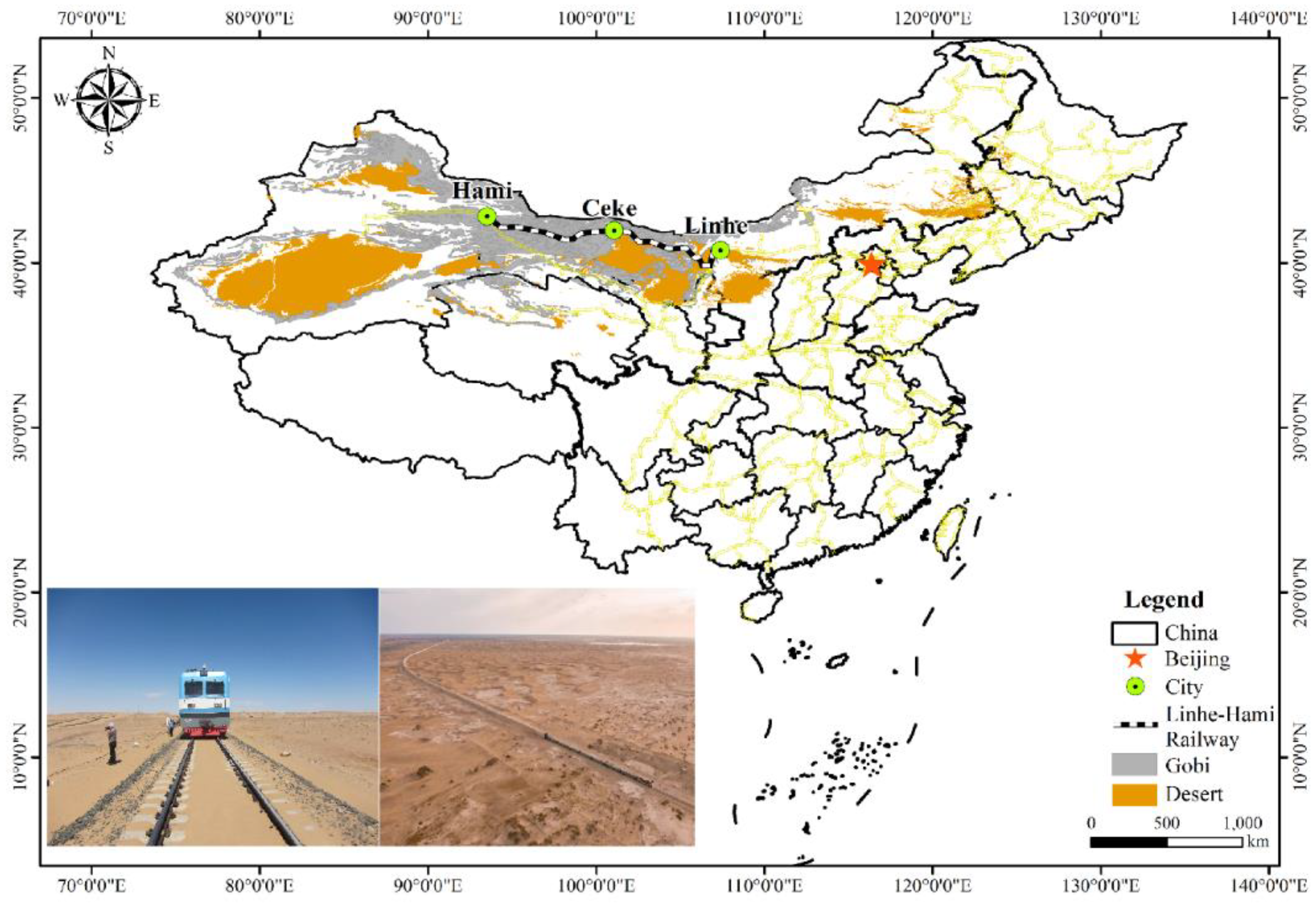
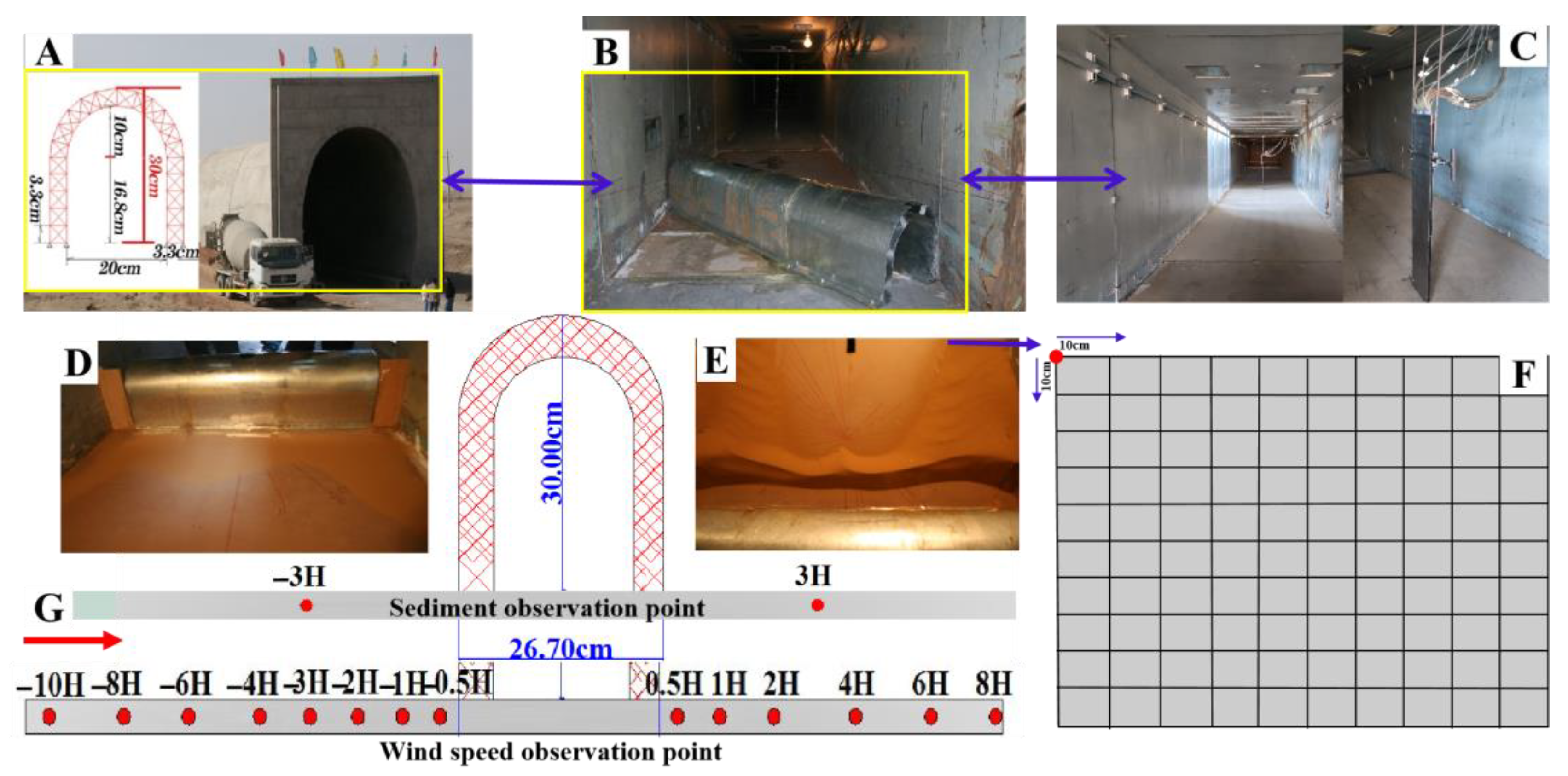




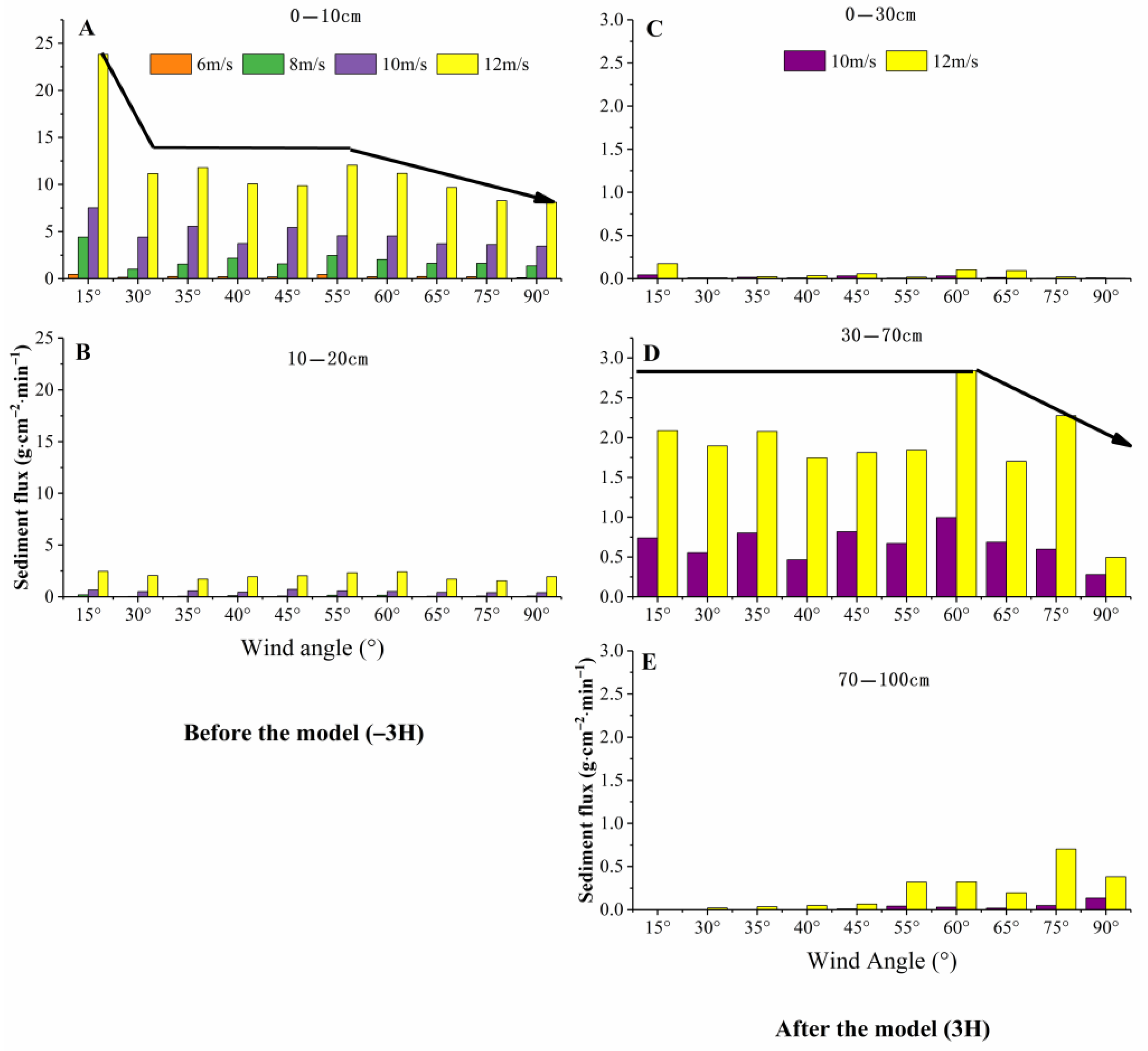
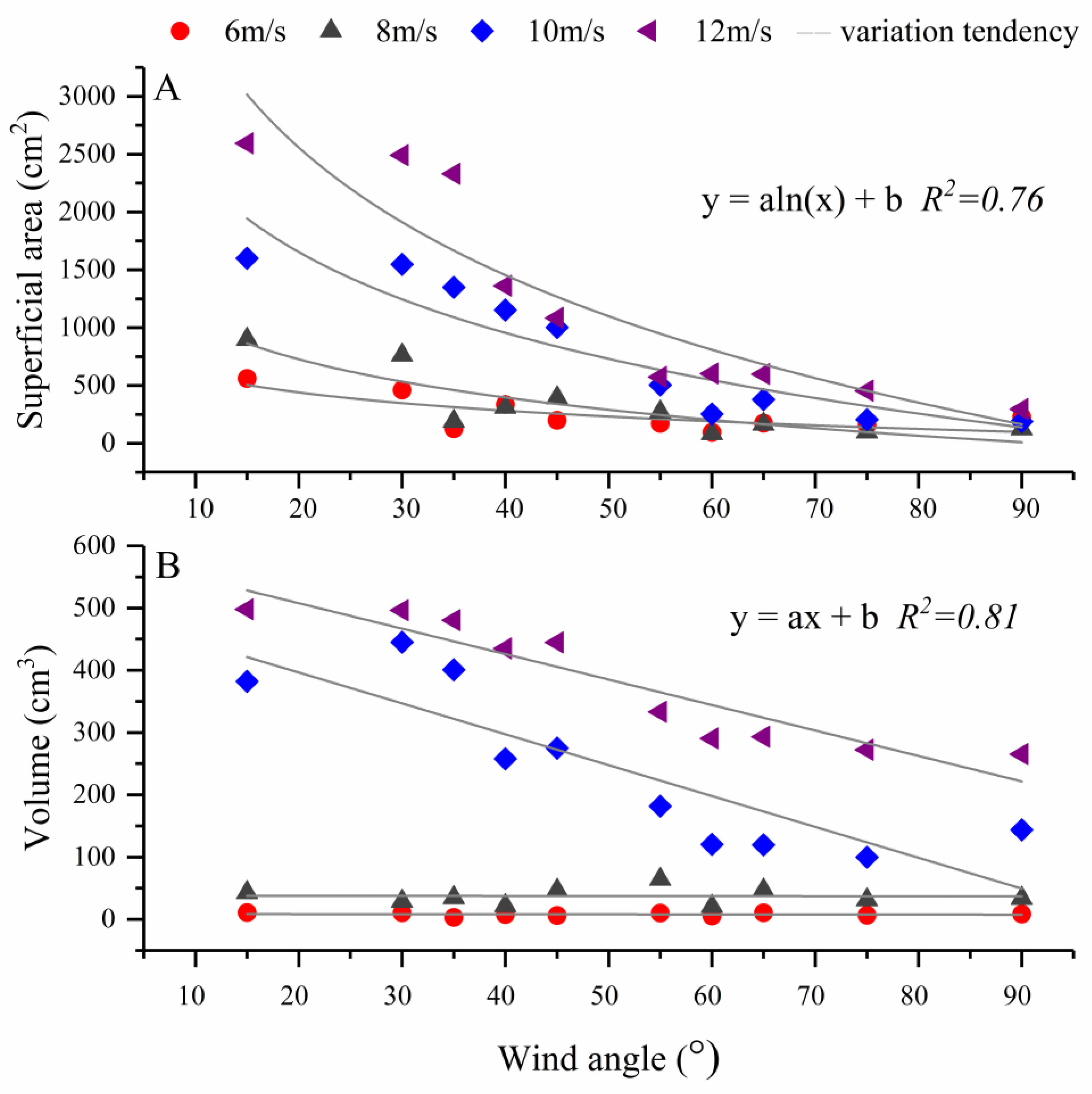
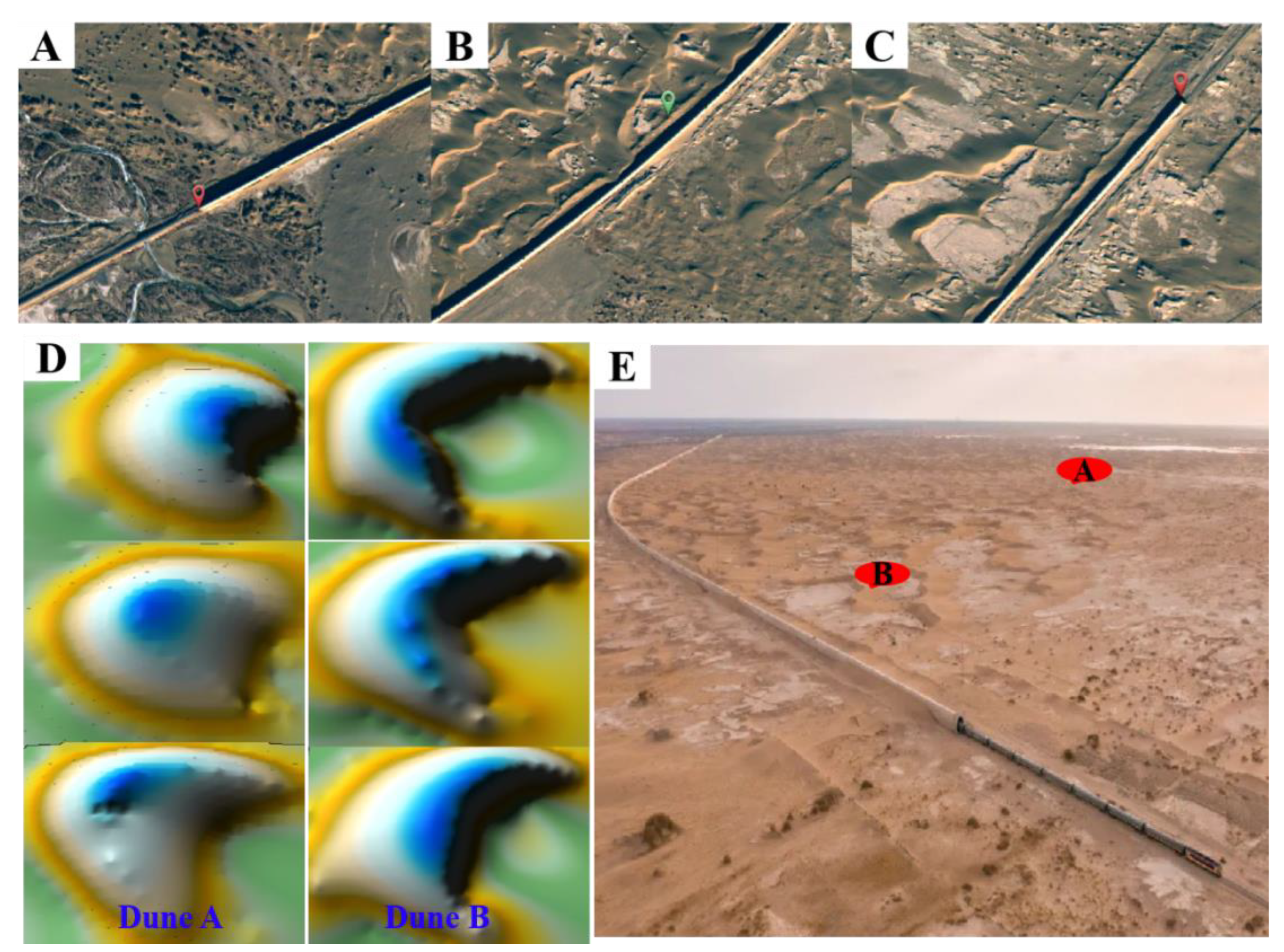
| Angle (°) | Wind Speed (m/s) | Sediment (g) | Sediment Flux (g/cm2/min) | Precent of Sediment Flux | Superficial Aera (cm2) | Volume (cm3) | |||||||
|---|---|---|---|---|---|---|---|---|---|---|---|---|---|
| Front | Rear | Front | Rear | Front | Rear | ||||||||
| U10/U | U20/U | U10/U20 | U0–30/U | U30–70/U | U70–100/U | ||||||||
| 15° | 6 | 19.11 | - | 0.48 | - | 0.99 | 0.01 | 91.31 | - | - | - | 561.97 | 10.99 |
| 8 | 147.69 | - | 4.62 | - | 0.96 | 0.04 | 22.54 | - | - | - | 899.41 | 43.18 | |
| 10 | 163.82 | 15.68 | 8.19 | 0.78 | 0.92 | 0.08 | 11.51 | 0.06 | 0.94 | 0.00 | 1600.97 | 382.12 | |
| 12 | 315.48 | 27.14 | 26.29 | 2.26 | 0.91 | 0.09 | 9.66 | 0.00 | 0.49 | 0.03 | 2592.47 | 498.04 | |
| 30° | 6 | 6.50 | - | 0.16 | - | 0.98 | 0.02 | 50.97 | - | - | - | 460.80 | 10.62 |
| 8 | 33.28 | - | 1.04 | - | 0.96 | 0.04 | 22.16 | - | - | - | 764.16 | 29.03 | |
| 10 | 98.39 | 11.27 | 4.92 | 0.56 | 0.90 | 0.10 | 8.59 | 0.19 | 2.22 | 0.00 | 1548.77 | 445.13 | |
| 12 | 158.57 | 23.11 | 13.21 | 1.93 | 0.84 | 0.16 | 5.45 | 0.01 | 0.96 | 0.17 | 2490.44 | 496.46 | |
| 35° | 6 | 9.93 | - | 0.25 | - | 0.99 | 0.01 | 67.98 | - | - | - | 127.2 | 3.28 |
| 8 | 52.00 | - | 1.63 | - | 0.96 | 0.04 | 25.44 | - | - | - | 190.58 | 34.98 | |
| 10 | 122.94 | 16.45 | 6.15 | 0.82 | 0.90 | 0.10 | 9.47 | 0.01 | 0.67 | 0.00 | 1349.22 | 400.74 | |
| 12 | 162.02 | 25.64 | 13.50 | 2.14 | 0.87 | 0.13 | 6.89 | 0.03 | 0.78 | 0.02 | 2329.78 | 480.48 | |
| 40° | 6 | 9.00 | - | 0.22 | - | 0.98 | 0.02 | 61.47 | - | - | - | 334.80 | 7.72 |
| 8 | 46.18 | - | 1.44 | - | 0.95 | 0.05 | 17.50 | - | - | - | 313.05 | 22.05 | |
| 10 | 83.41 | 9.52 | 4.17 | 0.48 | 0.89 | 0.11 | 8.38 | 0.01 | 2.39 | 0.03 | 1152.50 | 257.77 | |
| 12 | 144.20 | 21.99 | 12.02 | 1.83 | 0.84 | 0.16 | 5.20 | 0.06 | 1.55 | 0.18 | 1361.22 | 435.04 | |
| 45° | 6 | 7.56 | - | 0.19 | - | 0.99 | 0.01 | 102.53 | - | - | - | 200.00 | 6.34 |
| 8 | 53.55 | - | 1.67 | - | 0.95 | 0.05 | 18.58 | - | - | - | 393.12 | 46.51 | |
| 10 | 123.15 | 17.14 | 6.16 | 0.86 | 0.88 | 0.12 | 7.65 | 0.02 | 0.94 | 0.00 | 1003.41 | 275.15 | |
| 12 | 142.96 | 23.24 | 11.91 | 1.94 | 0.83 | 0.17 | 4.86 | 0.01 | 0.59 | 0.02 | 1084.76 | 444.61 | |
| 55° | 6 | 17.95 | - | 0.45 | - | 0.99 | 0.01 | 88.74 | - | - | - | 171.99 | 10.02 |
| 8 | 83.96 | - | 2.62 | - | 0.94 | 0.06 | 16.02 | - | - | - | 273.53 | 64.46 | |
| 10 | 102.99 | 14.38 | 5.15 | 0.72 | 0.89 | 0.11 | 7.97 | 0.02 | 1.73 | 0.03 | 504.06 | 181.97 | |
| 12 | 172.69 | 26.17 | 14.39 | 2.18 | 0.84 | 0.16 | 5.18 | 0.04 | 0.78 | 0.09 | 573.30 | 333.42 | |
| 60° | 6 | 8.53 | - | 0.21 | - | 0.98 | 0.02 | 56.61 | - | - | - | 95.55 | 5.70 |
| 8 | 69.88 | - | 2.18 | - | 0.93 | 0.07 | 13.30 | - | - | - | 85.14 | 20.96 | |
| 10 | 101.56 | 21.16 | 5.08 | 1.06 | 0.90 | 0.10 | 8.53 | 0.01 | 0.44 | 0.00 | 254.39 | 120.40 | |
| 12 | 163.31 | 39.22 | 13.61 | 3.27 | 0.82 | 0.18 | 4.59 | 0.00 | 0.30 | 0.02 | 603.45 | 290.43 | |
| 65° | 6 | 9.78 | - | 0.24 | - | 0.93 | 0.07 | 12.76 | - | - | - | 175.12 | 10.68 |
| 8 | 53.93 | - | 1.69 | - | 0.97 | 0.03 | 33.09 | - | - | - | 166.52 | 47.23 | |
| 10 | 82.80 | 14.34 | 4.14 | 0.72 | 0.89 | 0.11 | 8.50 | 0.03 | 1.46 | 0.04 | 380.24 | 119.56 | |
| 12 | 136.55 | 23.88 | 11.38 | 1.99 | 0.85 | 0.15 | 5.69 | 0.01 | 1.14 | 0.35 | 599.27 | 293.33 | |
| 75° | 6 | 8.74 | - | 0.22 | - | 0.98 | 0.02 | 52.94 | - | - | - | 158.40 | 6.56 |
| 8 | 54.56 | - | 1.71 | - | 0.96 | 0.04 | 23.27 | - | - | - | 98.80 | 31.67 | |
| 10 | 80.66 | 13.01 | 4.03 | 0.65 | 0.90 | 0.10 | 8.98 | 0.05 | 1.25 | 0.01 | 206.74 | 99.88 | |
| 12 | 118.05 | 35.99 | 9.84 | 3.00 | 0.84 | 0.16 | 5.32 | 0.01 | 0.15 | 0.08 | 455.40 | 272.27 | |
| 90° | 6 | 4.02 | - | 0.10 | - | 0.98 | 0.02 | 42.19 | - | - | - | 229.40 | 8.80 |
| 8 | 46.20 | - | 1.44 | - | 0.95 | 0.05 | 19.88 | - | - | - | 126.72 | 33.87 | |
| 10 | 77.38 | 8.49 | 3.87 | 0.42 | 0.89 | 0.11 | 8.38 | 0.08 | 2.56 | 0.09 | 189.80 | 143.90 | |
| 12 | 120.61 | 10.56 | 10.05 | 0.88 | 0.81 | 0.19 | 4.19 | 0.00 | 0.56 | 0.43 | 296.01 | 265.35 | |
Publisher’s Note: MDPI stays neutral with regard to jurisdictional claims in published maps and institutional affiliations. |
© 2022 by the authors. Licensee MDPI, Basel, Switzerland. This article is an open access article distributed under the terms and conditions of the Creative Commons Attribution (CC BY) license (https://creativecommons.org/licenses/by/4.0/).
Share and Cite
Yan, M.; Zuo, H. Will Wind–Sand Activity Bury the Opencut Tunnel along the Linhe–Ceke Railway, China? Sustainability 2022, 14, 11684. https://doi.org/10.3390/su141811684
Yan M, Zuo H. Will Wind–Sand Activity Bury the Opencut Tunnel along the Linhe–Ceke Railway, China? Sustainability. 2022; 14(18):11684. https://doi.org/10.3390/su141811684
Chicago/Turabian StyleYan, Min, and Hejun Zuo. 2022. "Will Wind–Sand Activity Bury the Opencut Tunnel along the Linhe–Ceke Railway, China?" Sustainability 14, no. 18: 11684. https://doi.org/10.3390/su141811684
APA StyleYan, M., & Zuo, H. (2022). Will Wind–Sand Activity Bury the Opencut Tunnel along the Linhe–Ceke Railway, China? Sustainability, 14(18), 11684. https://doi.org/10.3390/su141811684





